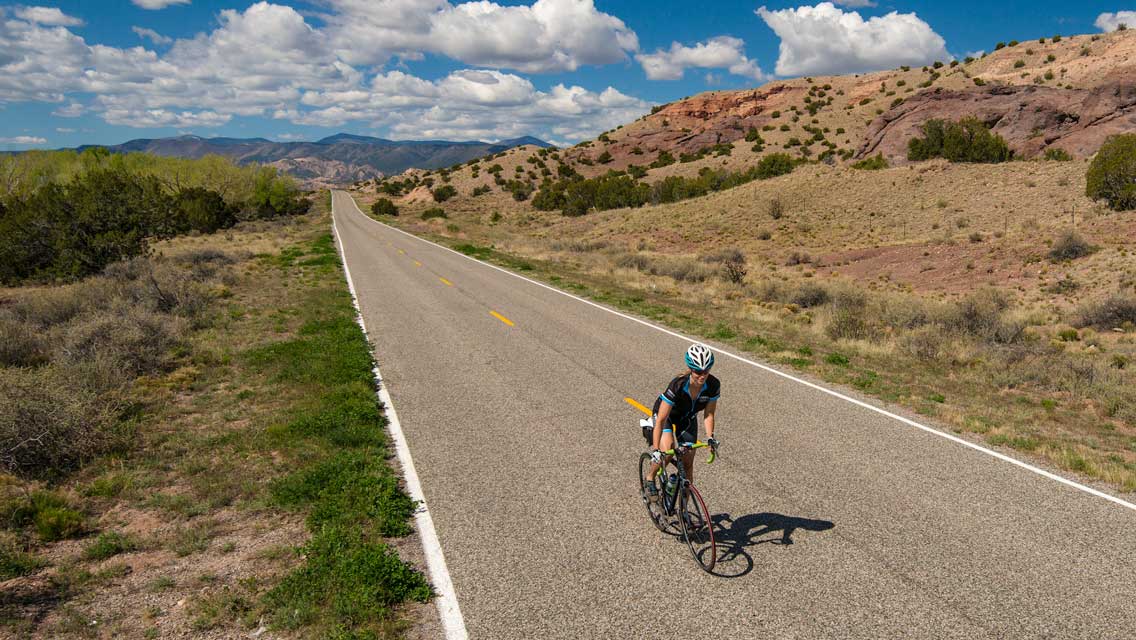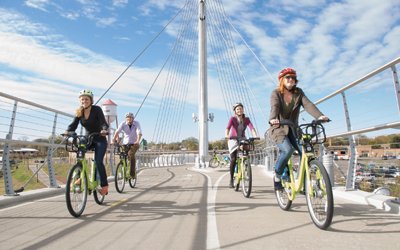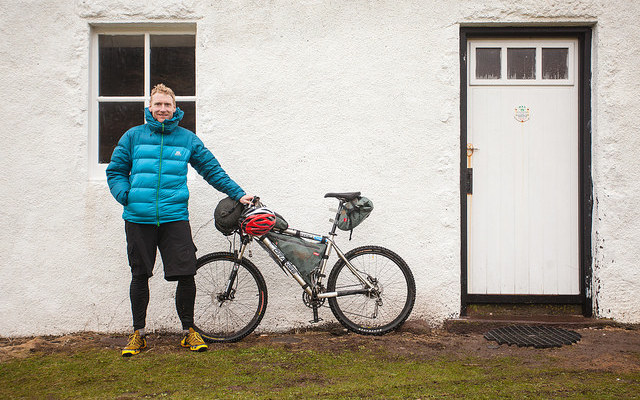On one of my first road-biking adventures, my husband, Carlton, and I pedaled 15 miles through the rolling hills of Vermont. After wheeling past quaint barns, golden haystacks, and historic bridges along the lightly trafficked back roads, we stopped to admire the profile of Mount Mansfield. Resting in the shadow of the Green Mountain State’s highest peak, we discussed our kids, jobs, and lifetime goals, and how my decision to hop on a bike connected us in a whole new way.
“When you spend several hours a day riding next to someone, you learn a lot,” explains Nan Doyal, a cycling coach from Glencoe, Ill. “Not just through conversations, but also in how they deal with the inevitable challenges you all face at some point — heat, fatigue, climbs — how they communicate, and how they handle adversity.”
As a fiercely independent female athlete who literally outran her five brothers while growing up in a place known more for its ski slopes than its bike paths, I didn’t always think I needed a bicycle. But a freak trail-running accident in March 2013 led me to adopt the sport as an easy-to-learn recovery tool.
“Road biking doesn’t require as much bike-handling skill as mountain biking, and it’s more consistent,” says Olympic mountain biker Lea Davison, who did 85 percent of her training for the 2016 Rio Games on a road bike. “It’s a great way to get into the sport of cycling and to get fit.”
Biking helped heal my injury and improved my fitness, but the challenge of grinding out a long climb and the joy I found in coasting down the other side of the hill also gave me a fresh perspective on life, improved my resilience, and rejuvenated my relationships.
Back in the Saddle
The x-rays from my unlucky break showed more parts of me in pieces than just my lower right-leg bones. Running was my meditation, my muse, my me. It was as habitual as brushing my teeth.
So I was a little depressed as I was forced to don a series of immobilizing fixators and casts. Eventually, my doctor gave me the green light to ride a stationary bike. Carlton, who’d recently made the switch to cycling, was thrilled, and he invited me to try his brand-new road bike on an indoor trainer.
Pedaling in front of the TV was no sweat. Once we moved outside, however, I was perspiring before I left the driveway.
First, there was the inevitable struggle to get comfortable wearing the clipless shoes — designed to twist in and out of brackets on the pedals. Cyclists often wear them because they offer increased efficiency and better power transfer on hills.
I’d ridden a bike plenty of times with regular sneakers, but mastering the art of clicking out of the pedals at stop signs resulted in a fair number of falls. Carlton tried not to laugh, but eventually we were both giggling as I got used to twisting in and out of the contraptions and felt comfortable enough to venture down the street.
Slow Start
By the fall, I was riding with friends, but feeling frustrated — they were faster than me! I struggled to keep up and could barely hear what they were saying about our children’s soccer schedules or the latest episode of Orange Is the New Black. Would I ever advance from the back of the pack?
I was ready to hang up my jersey some days, but my friends inspired me to keep going. Julie cruised past Vermont’s apple orchards with her strong glutes and quads. Sara taught me how to power up hills by using my bike’s multiple gears, proper cadence, and my body’s good old, reliable lungs.
Cycling eventually provided not only another way to connect with Carlton, but a new social outlet as well — one that was less expensive, healthier, and more supportive than hitting the local watering hole. It also helped me develop a new set of life skills for maintaining my balance — on and off my bike.
Breaking Away
That winter, my dedication paid unexpected dividends. Thanks to the strength I’d gained from biking, I was able to run again. I stashed my bike in the garage and laced up my shoes for bouts on the treadmill or along snow-covered roads. I even won a Valentine’s Day 5K. I felt fitter than ever, fully recovered from my injuries.
None of this came as a surprise to Davison. “Training on the road is how I develop a lot of my endurance for mountain-bike racing,” she says. The scenery, she adds, is just a bonus. “It’s a great way to get strong at the same time as really exploring the landscape. I get to see a lot more from my saddle than on a run.”
By May, I found myself eagerly eyeing the long, sinewy stretches of pavement knitting together the Green Mountains, ready to ride and experience the world — and myself — from the seat of my bike.
Carlton and I planned a daylong, 40-mile adventure to Vergennes, Vt. We booked a sitter for the kids and wheeled off into the sunrise with a French bakery as our destination. We kept count of the chickens we saw and marveled at the mountain views as we pedaled.
Later, as I eased my sore body into a chair to enjoy my hard-earned chocolate croissant and iced coffee, I realized I really did need a bicycle. And maybe a massage.
Call of the Open-Road Tour
Looking for a new way to explore a region or take on a fresh vacation challenge? “Road cycling and touring give you a chance to actually see, feel, and explore an area,” says Judy Watt, 69, a retired Toronto resident who’s been cycling since 1984. “The combination of fitness, personal achievement, and the chance to visit new and interesting places is really appealing.”
Tours aren’t just for experienced or elite cyclists. There are options available for almost every level of rider. You can bring your own bike and gear, but if you don’t want to ship yours to the tour location, most reputable road-bike tour companies will rent you the equipment you need.
Here are a few popular cycling tours to consider the next time you’re feeling the urge to hit the open road.
California Wine Valleys
The Route: It’s time to uncork a vintage adventure with a six-day, five-night ride through five regions known for their excellent vineyards, including Napa, Sonoma, and the Russian River. Highlights include a side trip to Bodega Bay, visits to hot-springs spas, and wine tastings at Plumpjack, Silver Oak, and Frog’s Leap, among other world-class wineries.
Challenge: Easygoing to avid riding, with daily travel ranging from 14 to 68 miles and elevation gains from 800 to 5,500 feet
Contact and Current Pricing: Backroads, www.backroads.com, 800-462-2848
Texas Hill Country
The Route: Barbecue, bluegrass, and bikes (not to mention bluebonnets and brand-new buddies) come together on this six-day loop that begins and ends in San Antonio. Traveling 36 to 71 miles a day through the rolling hills of south-central Texas, you’ll view historic sites, cypress forests, and plenty of longhorns. Highlights include Lyndon B. Johnson National Historical Park, the Guadalupe River Road, and the famous Salt Lick BBQ joint.
Challenge: For intermediate to advanced road riders. Guides also offer electric bikes for those who prefer them.
Contact and Current Pricing: Lizard Head Cycling Guides, www.lizardheadcyclingguides.com, 970-728-5891
Vermont’s Green Mountains
The Route: The tour begins in Burlington and winds through the heart of the Green Mountains, passing horse farms, glittering lakes, and covered bridges before finishing with the “Von Trapp” loop in Stowe, home of The Sound of Music family. It’s quintessential New England, with 14 to 43 miles of riding per day.
Challenge: Designed for active and recreational riders alike, this trip welcomes even nonriders: Those without wheels can enjoy the sights from a support van.
Contact and Current Pricing: Trek Travel, www.trektravel.com, 866-464-8735
Tips to Prepare for Your Road-Biking Adventure
- Consult with staff at a reputable bike shop about what type of two-wheeler is best for you, whether you’re looking to buy or rent. A road bike, with its skinny tires and lightweight steel, carbon, or aluminum frame, is designed for longer and faster rides, while a touring model, with its slightly wider wheels and a heavy-duty frame, is great for carrying gear in panniers or bags. These experts will help you find one that fits your height, weight, budget, riding ability, and goals.
- Start training early. Long-distance cycling can be demanding. Put on your training wheels a few months before your getaway to build up to the daily — and total — mileage you expect to ride during the tour. Once you feel strong and confident in the saddle, practice climbing hills to boost strength and ride longer distances to improve endurance. Don’t forget to mix in rest days!
- Get the right gear. Must-have items — beyond the basics of a helmet, front and back lights, a jersey with pockets, padded shorts, and sunglasses — include a repair kit with spare tubes, Allen wrenches, seat bag, and at least one water bottle. Stash your cell phone in your jersey pocket or seat bag for emergencies.
- Learn the specific rules of the road for cyclists in your state and the state where you’ll be riding, and familiarize yourself with biking hand signals for safe turns.



This Post Has 0 Comments